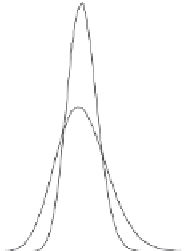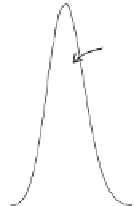Geoscience Reference
In-Depth Information
5
n=120
nK=1
4
u
3
40
2
10
1
n=2
0
1
2
0
3
t
Fig. 12.21 The unit response function (12.41) (i.e. the gamma density function) approaches a delta function as
n
becomes very large. The curves shown are for
n
=
2, 5, 10, 20, 40, 80 and 120. To allow easy
comparison between the different curves as
n
increases, their centers of gravity, i.e. the first moments
(12.42), are maintained at
t
=
1 by putting
K
=
1
/
n
in Equation (12.41).
assumes the characteristics of a delta function, as defined in Equations (A5)-(A7); it
should be recalled that the delta function is also the unit response function of the linear
kinematic channel, as formulated in Equation (5.124). This means that a tank cascade
consisting of a finite number of storage elements is in fact intermediate between two
extremes, namely “pure” storage action with
n
=
1, and “pure” translatory action with
n
, and that Equation (12.41) provides some weighted average of both effects. Put
differently, a finite set of storage elements is capable of accommodating not only storage
effects but also the translatory effects of the hillslopes and of the channel network in the
catchment.
A second feature is that, while Equation (12.41) is derived for a cascade consisting
of storage elements with the same value of the storage coefficient
K
, this result is not
very sensitive to this restriction. The following example illustrates this.
→∞
Example 12.8. Cascade with unequal storage elements
=
In the case of
n
2 tanks, each with a different value of the storage coefficient, namely
K
1
and
K
2
, instead of Equation (12.38), the unit response function becomes
t
exp(
−
τ/
K
1
)
exp[
−
(
t
−
τ
)
/
K
2
]
u
2
(
t
)
=
d
τ
K
1
K
2
0
or, upon integration,
exp(
−
t
/
K
1
)
−
exp(
−
t
/
K
2
)
u
2
(
t
)
=
(12.44)
K
1
−
K
2





































































































